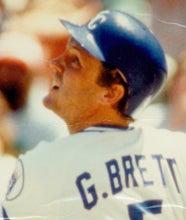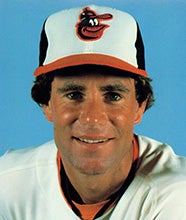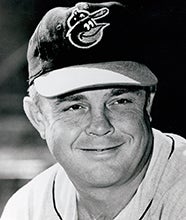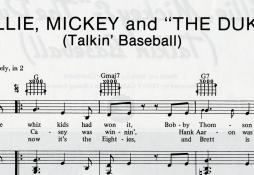- Home
- Our Stories
- #CardCorner: 1984 Topps Scott McGregor
#CardCorner: 1984 Topps Scott McGregor
The epitome of a soft-tossing left-hander, Scott McGregor was in no way a typical major leaguer.
McGregor won 138 games over 13 seasons, totaled 83 complete games and authored a shutout in the deciding game of a World Series. And he did it all with only one season where he struck out as many as 100 batters.
Born Jan. 18, 1954, in Inglewood, Calif., McGregor became focused on pitching at a young age and starred in Little League.
Orioles Gear
Represent the all-time greats and know your purchase plays a part in preserving baseball history.
Hall of Fame Membership
There is no simpler, and more essential, way to demonstrate your support than to sign on as a Museum Member.
“He would mark off on each board of a redwood fence what he thought the strike zone was,” John McGregor, Scott’s father, told the Redondo (Calif.) Reflex in 1972. “Then he would pace off what he thought the Little League pitching distance was. He would keep throwing until he had knocked that board down, then go to the next one. We have a brick wall up there now.”
Ambidextrous as a youngster, McGregor focused on throwing left-handed with the idea of becoming a pitcher or first baseman. He pitched his Babe Ruth team to the national championship in 1969, going 9-0 with seven shutouts. Then, in high school, McGregor pitched multiple no-hitters and became known as the top high school pitcher of his era in Southern California.
McGregor was high school teammates with Hall of Famer George Brett at El Segundo High School and later battled in the big leagues, with McGregor holding Brett to a .222 batting average (12-for-54).
“He was a good basketball player,” Brett told the Kansas City Star in 1980, noting that McGregor was also a good-hitting first baseman. “He played football as a freshman. But he didn’t play later because he knew he’d have a career in baseball.
“I think in the four years he played varsity (baseball) he was like 51-5. He broke all my brother (Ken’s) records his junior year. He had such good control he would throw 2-0 curveballs and 3-2 curveballs in high school. No one does that.”
McGregor was selected in the first round of the 1972 MLB Draft by the Yankees with the 14th overall pick. He had committed to attend the University of Southern California, but a bonus that was reported to be $85,000 convinced McGregor to head directly to pro ball. Though he was only 18, McGregor was sent to the Class A Florida State League – and he thrived against the older competition, going 7-3 with a 2.73 ERA in 11 starts.
“In high school, I just tried to overpower people,” McGregor told the Sporting News in 1973. “But in Florida, when I tried to blow it by a batter, I was getting hit hard. So I worked on my control…on becoming a more complete pitcher.”
The Yankees were so impressed with McGregor’s mature approach that they invited him to Spring Training in 1973. He was sent to West Haven of the Double-A Eastern League that year, where he went 12-13 with a 3.29 ERA.
“The kid has incredible poise,” West Haven manager Doc Edwards said. “Nothing fazes him. He is a super prospect.”
McGregor made headlines that winter when Oakland A’s owner Charlie Finley asked the Yankees for McGregor and outfield prospect Otto Vélez in return for letting manager Dick Williams – who resigned after the 1973 World Series but was still under contract – take the job in New York. The Yankees turned down the request and hired Bill Virdon as manager.
Meanwhile, McGregor began a frustrating two-and-a-half year stint in Triple-A Syracuse. Seemingly ready for the big leagues but unable to crack a veteran Yankees staff, McGregor went 13-10 with a 3.44 ERA in 1974 and followed that up with a 6-9 mark and 3.99 ERA in 1975. Sitting in the dugout in Charleston, W.Va., on Aug. 9, 1975, McGregor was struck by a thrown ball during infield practice and suffered a broken collarbone.
“It was really frustrating,” McGregor told the Daily Breeze of Torrance, Calif. “I was having a bad year and just starting to throw good.”
McGregor opted to play winter ball in Venezuela after the season and regained his confidence with a 10-4 record.
“In Syracuse, I messed up,” McGregor said just before the start of Spring Training in 1976. “I let (not getting the call to the big leagues) get to me.
“I think I’m ready. I have to get there and make the ballclub, and I know the way I’m throwing now it’s going to be my year. It’s got to be my year.”
It was – but not the way McGregor anticipated. Sent back to Syracuse to start the season, McGregor was struggling when the Orioles swung a deal with the Yankees that would benefit the team for years to come. Baltimore sent Doyle Alexander, Jimmy Freeman, Elrod Hendricks, Ken Holtzman and Grant Jackson to the Yankees in exchange for Rick Dempsey, Tippy Martinez, Rudy May, Dave Pagan and McGregor on June 15, 1976.
It was a deal the Yankees made to acquire veteran pitching for their push for their first playoff berth in 12 seasons – and the Yankees did indeed win the American League East that year and advanced to the World Series. But in Dempsey, Martinez and McGregor, the Orioles acquired three players that would each play in Baltimore for more than a decade.
McGregor remained in the International League after the trade, moving to Baltimore’s Triple-A outpost in Rochester and finishing with a combined record of 12-6. The Orioles brought him up to the big leagues in September, where he made two starts among three appearances – going 0-1 with a 3.68 ERA.
Making the big league roster in 1977 as a bullpen arm, McGregor picked up his first win on April 20 against Cleveland and continued to make spot starts throughout the year for a Baltimore team that won 97 games using a veteran rotation that featured Jim Palmer, Rudy May, Mike Flanagan and Ross Grimsley along with swingman Dennis Martinez.
But when May was traded to the Expos following the season and Grimsley departed for Montreal via free agency, McGregor saw his chance to join the rotation. He became one of manager Earl Weaver’s workhorses that season, going 15-13 with a 3.32 ERA in 233 innings.
But tendinitis in his elbow that bothered McGregor at the end of the 1978 season carried over into Spring Training of 1979. He tried to pitch through the pain but ended up on the disabled list and missed a month of action before returning in late May.
After getting his feet back under him, McGregor notched his first win of the season by shutting out the White Sox on June 11. He racked up four wins in July and added four more in August as the Orioles sprinted toward the AL East crown. McGregor threw four straight complete games in late August and early September – and Baltimore won 102 games to coast to the division title by eight games over the Brewers. McGregor finished the season with a 13-6 record and 3.35 ERA.
In the ALCS vs. the Angels, the Orioles appeared headed to a three-game sweep when Al Bumbry’s ninth-inning error in center field allowed California to rally to a 4-3 win in Game 3.
McGregor, slated to start Game 4, guaranteed an Orioles win when he stood up on the team bus following Game 3 and said so.
“Yes I did guarantee the team would win today,” McGregor told United Press International after pitching a six-hit shutout in Baltimore’s 8-0 win that sent the Orioles to the World Series. “It was the biggest game of my life.”
Scott McGregor got his first taste of the postseason in 1979 and tossed complete-game victories in his first two starts. But he took a tough-luck loss in Game 7 of the World Series, allowing just two runs over eight innings. (Doug McWilliams/National Baseball Hall of Fame and Museum)
The Orioles were heavy favorites against the Pirates in the World Series – “This is the best team I’ve ever had,” Baltimore manager Earl Weaver told UPI – and McGregor helped give his team a 2-games-to-1 lead when he pitched a complete game in Baltimore’s 8-4 victory in Game 3.
“You couldn’t ask a pitcher to do any better than Scotty did during the stretch and in the postseason games,” Baltimore pitching coach Ray Miller told the Associated Press.
Baltimore won Game 4 to push the Pirates to the brink of elimination, but Pittsburgh won Games 5 and 6 to force a deciding Game 7. McGregor started that contest and blanked the Pirates through five innings, holding a 1-0 lead on the strength of a homer by Rich Dauer. But in the sixth, Bill Robinson singled with one out, and Willie Stargell followed with a home run to right-center field to give Pittsburgh a 2-1 lead.
McGregor held the Pirates scoreless in the seventh and eighth but was removed to start the ninth with Pittsburgh still leading 2-1. The Pirates then scored twice against five Baltimore relievers, and Kent Tekulve retired the Orioles in order in the ninth to preserve the 4-1 win.
“I got one pitch down in the strike zone and (Stargell) hits it out,” McGregor told the Fort Worth Star-Telegram after Game 7. “I made one mistake and he took advantage of it. I tell you, Mr. Stargell is one hell of a man.
“But we had a good season. I’m not going to pout.”
McGregor also found clarity in his personal life that season, becoming a Christian and renouncing his former lifestyle that had included alcohol and drugs.
“As soon as I became a Christian,” McGregor told the Baltimore Sun, “my career took off.”
McGregor had his best season in 1980, going 20-8 with a 3.32 ERA. He struck out 119 batters in 252 innings, the only time in his career that he topped the 100-strikeout mark. The Orioles won 100 games but finished second to the Yankees in the AL East.
Following the season, McGregor signed a new five-year deal with Baltimore.
McGregor went 13-5 with a 3.26 ERA in 1981, falling one win short of tying for the AL lead in victories and earning the only All-Star Game selection of his career.
The tendinitis that plagued McGregor for years resurfaced in 1982. He made a career-high 37 starts but was less effective than usual, going 14-12 with a 4.61 ERA. But in 1983, McGregor was healthy and the new-look Orioles – featuring young Cal Ripken Jr. – were poised for another run at the title.
McGregor won eight of his first 12 decisions before shifting to another gear in July, when he was named the American League’s Pitcher of the Month after going 5-0 in six starts with four complete games and a 2.26 ERA. He finished the year 18-7 with a 3.16 ERA, working a career-best 260 innings. He also became the last left-hander with at least 18 wins in a season where he did not strike out at least 100 batters, fanning 86 that year – right on par with his career average of 88 strikeouts in his nine seasons where he was a rotation regular.
Orioles manager Joe Altobelli tabbed McGregor as his Game 1 starter in the ALCS vs. the White Sox, and McGregor was a hard-luck loser in a 2-1 defeat – allowing only one earned run over 6.2 innings. But the Orioles won the next three games to advance to the World Series, setting up McGregor to pitch Game 1 of the Fall Classic against the Phillies.
Once again, McGregor was a tough-luck loser in Game 1, allowing only two runs over eight innings in a 2-1 loss. But once again, the Orioles won the next three – positioning McGregor to start Game 5. McGregor pitched the game of his life in this one, shutting out Philadelphia on five hits as the Orioles won the game 5-0.
When Garry Maddox’s line drive was caught by Ripken to end the game, McGregor and the Orioles clinched their elusive ring. A photo of McGregor embracing catcher Rick Dempsey ran in newspapers from coast to coast.
“Three-and-two to (Phillies leadoff hitter Joe) Morgan leading off the game and Scott made three good pitches on the outside corner,” Orioles pitching coach Ray Miller told the Los Angeles Times after Game 5, noting that Morgan struck out on the last pitch. “I said to myself: ‘Scott’s going to do it all tonight.’”
McGregor drew his first Opening Day start in 1984, but the workload of the previous seasons began to take its toll. He went 15-12 with a 3.94 ERA that season, missing the entire month of September after fracturing the ring finger of his pitching hand while fielding a ball hit by the Angels’ Brian Downing on Aug. 28.
In 1985, McGregor continued to post solid numbers but was no longer the 1983 version of himself, going 14-14 with a 4.81 ERA while leading all MLB pitchers with 34 home runs allowed. He was 11-15 with a 4.52 ERA in 1986, the last of six seasons where he topped the 200-innings pitched mark.
Then in 1987, McGregor struggled so much that the Orioles sent him to Triple-A in July for a quick attempt at regaining his form.
“Everything’s been uphill this year,” McGregor told the Baltimore Evening Sun of a season that ended with him being diagnosed with a torn rotator cuff.
After going 2-7 with a 6.64 ERA in 85.1 innings in 1987, McGregor tried a nonsurgical approach to his shoulder injury. He worked out with weights to try to strengthen the muscles around his left shoulder, but McGregor acknowledged that – even though his contract, which guaranteed him more than $1 million per season, ran through the 1989 season – he was probably not in the Orioles’ future plans.
“With the way I’ve pitched,” McGregor told the Washington Post in the spring of 1988, “I have to win people back again.”
But it was not to be. After going 0-3 with an 8.83 ERA in four starts, McGregor was released on May 2, 1988. He would not pitch in the big leagues again.
McGregor devoted much of the next decade to his faith before returning to pro ball as a minor league instructor in the new century. He served as the Orioles interim bullpen coach in 2013.
In 13 MLB seasons, McGregor was 138-108 with a 3.99 ERA. Without a dominant fastball, McGregor used location and change-of-speed to become one of the most effective starters of his era. He is the only pitcher whose career began in 1975 or later with at least 2,000 innings pitched (2,140.2) and fewer than 1,000 strikeouts (904).
But with every intangible at his disposal, McGregor fulfilled his dream of making it to the majors.
“I guess it’s because,” McGregor said in high school of his innate pitching ability, “I’ve been pitching almost all my life.”
Craig Muder is the director of communications for the National Baseball Hall of Fame and Museum
Related Stories

#CardCorner: 1981 Donruss Tippy Martinez

#CardCorner: 1978 Topps Otto Vélez
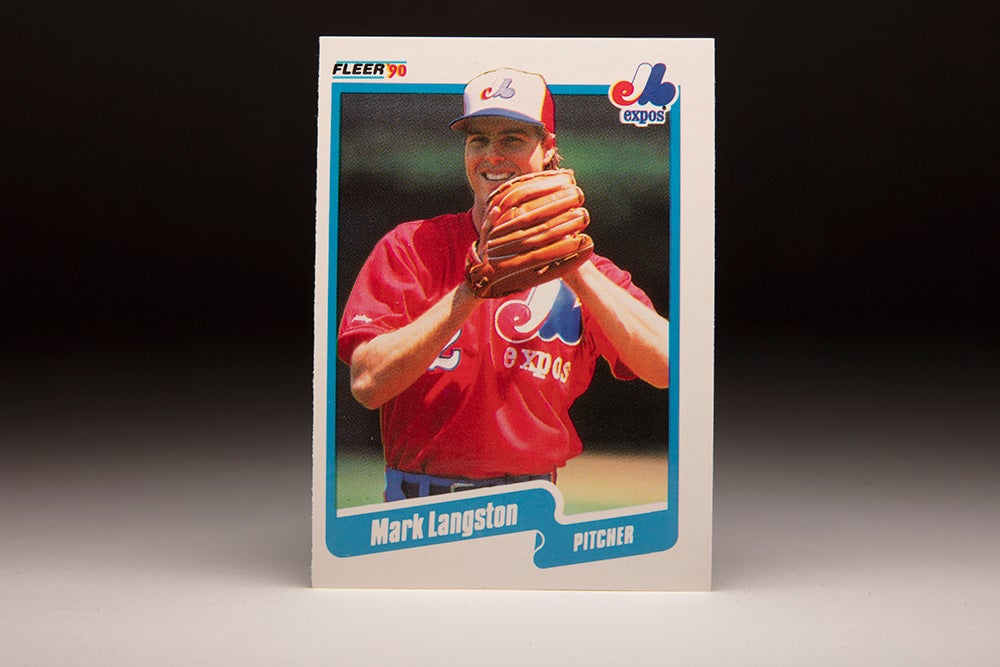
#CardCorner: 1990 Fleer Mark Langston
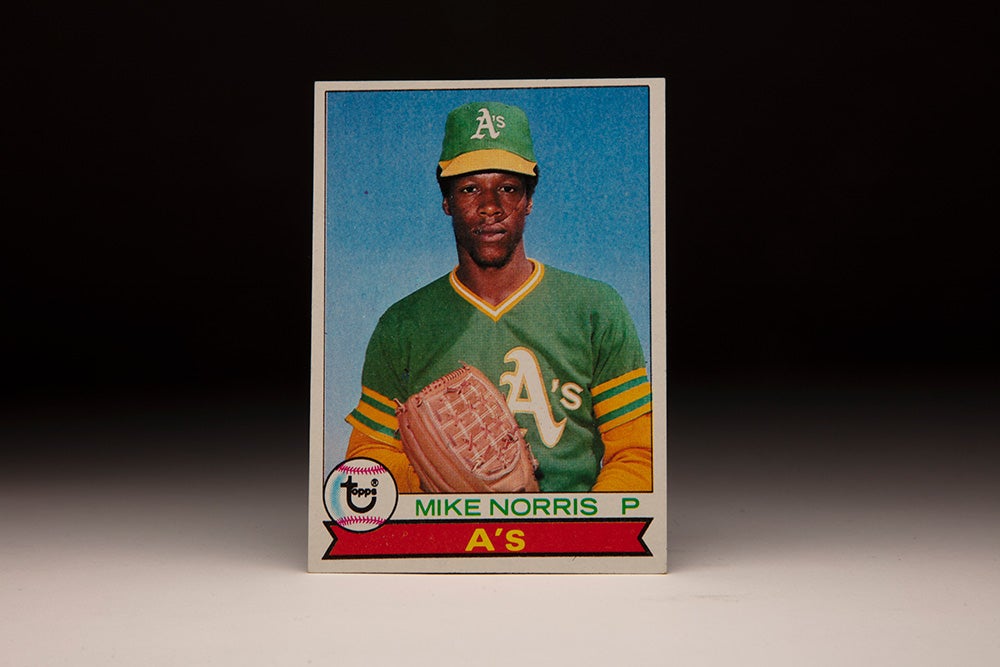
#CardCorner: 1979 Topps Mike Norris

#CardCorner: 1978 Topps Doug DeCinces
Related Stories

#CardCorner: 1984 Topps Scott McGregor

Tom Seaver Announces His Retirement

#CardCorner: 1981 Topps Tom Underwood
Writers Elect Four to the Hall for the First Time in 60 Years

#CardCorner: 1977 Topps John Lowenstein

Hall of Famers Who Played American Legion Baseball

#CardCorner: 1984 Topps Scott McGregor

World Series Glory Awaits
1999 Hall of Fame Game
01.01.2023
Museum Partners with Artist Bill Purdom for 75th Anniversary Artwork
01.01.2023






